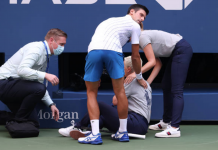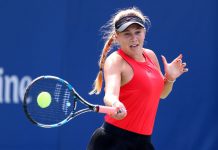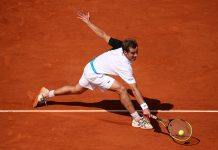University of Georgia head coach Manny Diaz has built up quite a collection of championship hardware in his 21 years at the helm, including four NCAA team titles and a conference-best seven SEC Tournament trophies. IT sat down with the Puerto Rican Tennis Hall of Famer at the U.S. Open:
IT: The history and fanfare of Wimbledon is great. Roland Garros has Paris, and the U.S. Open is an event like no other. But there’s nothing quite like an NCAA team final — six matches going on at the same time, fans yelling. What makes the atmosphere so special?
Manny Diaz: You’ve got kids playing with such heart, such enthusiasm. You can pick a match to watch from the six that are going on. Three doubles matches. You see great variety. It’s a little more “rah-rah.” It’s a zoo. It’s a jungle. It’s that kind of passion for the game that you see in college matches.
IT: For those who haven’t experienced May Madness on the Georgia campus before, how would you describe it?
MD: Our crowds were really, really rowdy when we started hosting the NCAAs. We hosted them now for 25, 27 years in the past 30 years. In the beginning, our crowd was basically a football crowd — the Deep South in the early ‘70s. But the more we hosted it, the more our fans became tennis fans, the more they became educated from just wild, football fans to being more informed. While our fans are right now many in numbers — we’ve got over 6,000 fans out there for the NCAA Championships — our fans are much more educated and tennis savvy than they used to be.
IT: What about the Dawg Pound?
MD: Those are grownups now [laughs].
IT: But in their day they were loud.
MD: They used to scream all kinds of stuff.
IT: The Bryan Bros used to say they were paralyzed with fear when they played in Athens and it was all they could do to keep their eye on the ball tossing it up for a serve.
MD: You don’t see that so much anymore. But if you asked the Bryan Bros. and they’d probably tell you that it’s one of the things that prepared them for the atmosphere in Davis Cup. While the enthusiasm and anxiety are similar, what makes college tennis — and the NCAA final in particular — so special is that you’re 10 or 12 guys who get to that moment after an entire year of working together and going through many challenges. You dream about that moment. We get up at 6 o’clock in the morning and go through conditioning workouts to get to that point. It becomes such an enormous deluge of emotion once you get to that point. It stops being about you. It’s about us as a team and what it would mean for everybody.

IT: If you had to pinpoint the key to your success…
MD: It’s tough to say. Our approach is to develop a cohesive team philosophy. I’ve done my job if I’ve identified our journey, our goal setting and held them accountable to each other, where all of a sudden it becomes, ‘What can I do to serve the interest of the group?’ If I can sell that to the guys, they begin to take ownership of their success as a team. It goes from day-to-day practice when somebody hasn’t gotten a whole lot of sleep because they have two exams and they’re underperforming. It affects their attitude. Then I try to get the other guys to come in and make a difference. So it’s about leadership and accountability. Through all that you develop the mindset, the belief, a sense of expectancy.
IT: You had so much success — four NCAA team titles in ‘99, ‘01, ‘07 and ‘08, seven SEC tournament championships, a 488-100 record over 21 seasons, the undefeated 32-0 team of ‘07, a 62-match winning streak at home — but what’s your proudest moment?
MD: To create the kind of bonds that last a lifetime. John Isner and I call each other twice a week and we text each other just about every day. You make a little difference in somebody’s life. The friendship, the respect is there. I’ve got guys who went to medical school. I’ve got guys who are doing wonderfully in the business world. Staying in touch with them and knowing that they appreciated the four years they were at Georgia is what’s most rewarding.
IT: You mention Isner — he took out Andy Roddick in five sets at the U.S. Open and has now climbed up to No. 42.
MD: He’s just got a great attitude. He’s a tremendous kid. He’s enjoying the ride. But more than that, he seems to be treating things professionally. He’s gotten more serious about his training. Craig Boynton’s doing a tremendous job with him. He’s working hard and working on the things that are going to make him a better player.
IT: By dropping 15 pounds under Larry Stefanki’s watch, Roddick seems to have sent a message.
MD: John’s strength training and flexibility work has always been very important. He really started getting really serious about those things in his sophomore and junior years in college because the nature of the beast — how big he is. It’s taken a lot of work and a lot of time. We put 40 pounds on him from his freshman to his senior year. He’s probably put on another eight or 10 pounds on after that.
IT: It’s a delicate balance. Put on too much weight and that might affect your footwork. Take off too much weight and you lose some muscle.
MD: That’s right. He needs to continue to work on his footwork, his agility. He’s never going to be as quick as a guy who’s 5-foot-10.
IT: How high can he climb in the rankings?
MD: He can make it in the top 20, 25. He’s on the way. He’s playing with confidence and is very focused.
IT: You followed Dan Magill. That was a little like Gene Bartow following John Wooden at UCLA, or Steve Young following Joe Montana with the 49ers.
MD: Everybody said, “This could be hard.” [Laughs.] The one thing that gave me a chance to succeed a legend was that I knew I would never replace him. I knew I would never be like him. I had to be myself. If you’re not yourself, they’re going to read through you. I was fortunate to be a part of the program as a player and as an assistant coach. The fact that I played under coach Magill made a difference. If I had come in as an assistant having not been a player, I would have had a much more difficult time. I kept most of the things we were doing, but I immediately stopped playing challenge matches. I didn’t believe in them. They were great when I was a player, because we only had one fall tournament. We had one winter tournament then the dual-match season. By the time I took over, we were playing four or five tournaments in the fall, three in the winter. Challenge matches became detrimental. The guys would get very uptight. There was more fighting.
IT: When John Roddick was playing at UGA did his brother, Andy, come around?
MD: He used to. He was 12 years old, running and hitting balls against the wall, chasing balls onto the grandstand, getting all muddy. Then when John was an assistant coach, Andy was a pro already, but he came back a couple of times and made a difference.
IT: People talk about a little island in the Mediterranean called Majorca, where a couple of decent players — Nadal and Moya — came from. But Puerto Rico often gets overlooked — Charlie Pasarell, Gigi Gernandez, etc. It’s a pretty good pipeline.
MD: There’s always a catalyst, and for tennis in Puerto Rico in the ‘60s and early ‘70s there was no one producing players but Welby Van Horn on four courts on the Caribe Hilton Hotel [in San Juan]. That’s the club we were members of. For many years, he produced more USTA gold ball winners than any other city in the Continental U.S. He was our catalyst. He produced Stanley Pasarell, Charlie Pasarell, Alberto Guerrero, Freddy DeJesus.
IT: If you had to pick an all-time Georgia lineup, who would your top six be?
MD: You’d have to go with our three NCAA individual champions — [two-time titlist] Mikeal Pernfors and Matias Boeker. While Isner didn’t win an NCAA single title, he was as good as those guys, as he’s proving on a big stage now. After that, we’ve got so many players. In 2001, we had Brandon Wagner playing No. 6. Our undefeated 2007 team from top to bottom.
IT: The influx of foreign players has been a hot-button issue. Many feel that Americans are losing out on scholarship opportunities to guys who often have Satellite experience under their belts.
MD: International players who have come in at the collegiate level have elevated and been very beneficial to the development of our American juniors. I just have a big problem with bringing in international kids who are 21, 22 as freshmen. In the past few years, we’ve passed down two rules that starting to affect what was going on, which was an uneven playing field. We have a rule that says after one year of your high school graduation you’ve got to enter college. Number two is, once you turn 20 you lose a year of eligibility. You have to sit out a year. That’s starting to balance things a bit. When I played team tennis in Germany, we were allowed only one foreigner per team. The ITA prepared a position paper to limit the number of international players. But a former judge came down and said, “This will never hold up in court.” We’re trying to strike a balance. We’re trying to make sure we’re developing American kids. We’re trying to make sure that the playing field is somewhat level — you’re not having a 23-year-old freshman playing against our 17-year-old Americans. It’s a bigger challenge than I thought it would be.
IT: There’s a guy who heads the USTA right now [Gordon Smith] who you know quite well. In fact you played doubles with him. What kind of game does he have?
MD: He had one of the nastiest lefty slice serves. That serve went everywhere. He had a great forehand. He’s a very smart player, and I’m sure he’s very smart in what he’s doing right now.
IT: There have been so many great college teams over the years — the USC teams, UCLA, Stanford with John McEnroe, your unbeaten team of 2007. If you had to pick the greatest collegiate team of all time, which one would it be?
MD: That ‘98 Stanford team that went undefeated had Paul Goldstein playing No. 4. Then you had our 2007 team. The Illinois team of 2002 that went undefeated. Our 2001 team didn’t go undefeated, but was every bit as good as some of those.


















